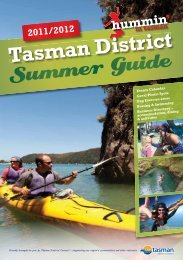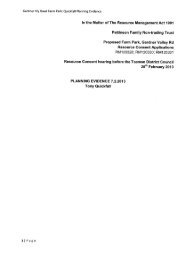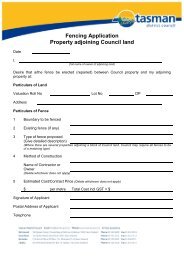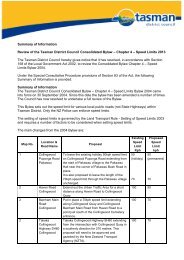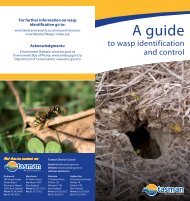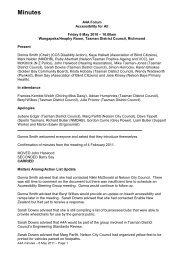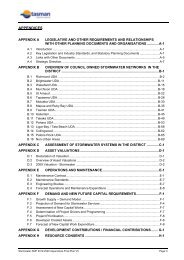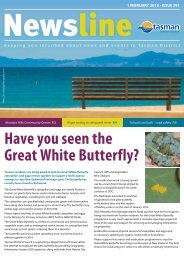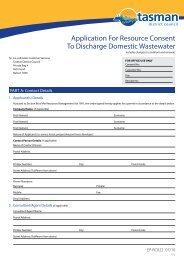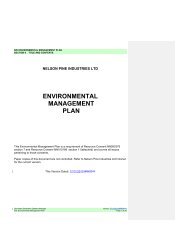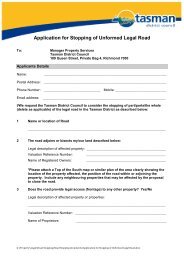Abel Tasman Foreshore Scenic Reserve Draft Management Plan
Abel Tasman Foreshore Scenic Reserve Draft Management Plan
Abel Tasman Foreshore Scenic Reserve Draft Management Plan
You also want an ePaper? Increase the reach of your titles
YUMPU automatically turns print PDFs into web optimized ePapers that Google loves.
2. Treaty of Waitangi<br />
2.1 Giving effect to the Treaty<br />
Under section 4 of the Conservation Act 1987, the Administration Committee is<br />
required to interpret and administer the <strong>Reserve</strong>s Act 1977 to give effect to the<br />
principles of the Treaty of Waitangi. However, where there is clearly an inconsistency<br />
between the provisions of the <strong>Reserve</strong>s Act 1977 and the principles of the Treaty, the<br />
provisions of the <strong>Reserve</strong>s Act 1977 will prevail. This is reflected in the Primary<br />
Objectives for the reserve.<br />
This plan is subject to the developing jurisprudence of the courts on the<br />
interpretation of the principles of the Treaty of Waitangi and to the outcome of<br />
Treaty Settlement negotiations, and should be read together with the Conservation<br />
General Policy 2005, particularly Chapter 2; and policies 4.1(e), 4.4(h), 5(c) and<br />
12(d) (see Appendix 10).<br />
In this plan, the tangata whenua whose rohe (tribal boundaries) cover the <strong>Abel</strong><br />
<strong>Tasman</strong> <strong>Foreshore</strong> <strong>Scenic</strong> <strong>Reserve</strong> include Ngāti Tama Ki Te Tau Ihu (Ngāti Tama),<br />
Te Ātiawa Ki Te Tau Ihu (Te Ātiawa) and Ngāti Rārua.<br />
The Administration Committee needs to work co-operatively with Ngāti Tama, Te<br />
Ātiawa and Ngāti Rārua, and any other iwi who may be recognised by the Crown as<br />
being tangata whenua of the reserve, in a spirit of partnership (based on mutual good<br />
faith, co-operation and respect) to achieve the objectives of this plan. A partnership<br />
approach recognises the mana of tangata whenua and the desire to work together to<br />
maintain and support the reserve.<br />
Tangata whenua need to be given the opportunity to be actively involved in the<br />
preservation of the reserve’s values, including wāhi tapu and other taonga. The<br />
Administration Committee recognises and respects the desire of tangata whenua to<br />
exercise kaitiakitanga/customary practices of guardianship, in relation to places or<br />
resources that have spiritual or historical and cultural significance for them. Active<br />
involvement by tangata whenua can be supported and achieved in a number of<br />
different ways. Some of these ways are:<br />
(i)<br />
(ii)<br />
(iii)<br />
(iv)<br />
(v)<br />
(vi)<br />
Providing tangata whenua with information and technical advice<br />
Communicating with tangata whenua about proposed work associated with the<br />
reserve<br />
Consulting tangata whenua regarding the protection of wāhi tapu and other<br />
taonga (see section 4.2 ‘<strong>Management</strong> of historical and cultural heritage’)<br />
Establishing partnerships with tangata whenua on restoration and pest<br />
management projects, where appropriate (see section 3.2 ‘Biosecurity and<br />
management of threats to indigenous species, habitats and ecosystems’)<br />
Enabling customary use by tangata whenua on a case-by-case basis (see section<br />
2.2 ‘Customary use’)<br />
Consulting with tangata whenua on concession applications that affect their<br />
interests (see section 8.1.3 ‘Māori cultural values’)<br />
(vii) Developing public information and interpretation which refers to places or<br />
resources of spiritual or historical and cultural significance to Māori, in<br />
2. Treaty of Waitangi 15



